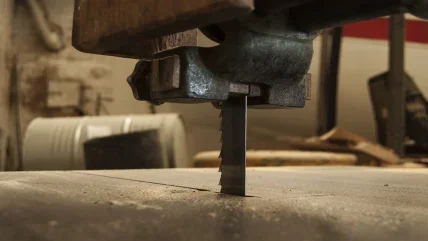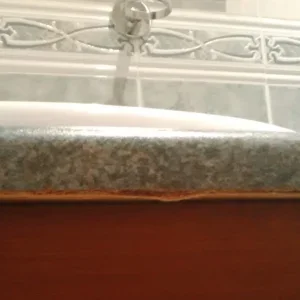
Based a short distance from Milan in Italy, Imeas has been one of the leading global suppliers of sanding technology for the primary wood-based panel manufacturing and metal working industries for decades.
Established in 1966, the company has made a point of developing new solutions to follow trends in the market and this past year has been no exception.
Its work with North America-based cross-laminated timber (CLT) and glulam beam producer Structurlam has led it to develop an entirely new, innovative and automatic sanding solution for the glulam beam market.
Imeas sales director Francesco Zenere told us that Imeas had this year supplied to Structurlam one sanding unit for CLT operations – for calibrating and finishing the top face of CLT boards – and a new machine altogether for Structurlam’s glulam beam production line. Both are at Structurlam’s new factory in Arkansas.
In the case of the new glulam line machine, Imeas had to develop a new machine entirely as it had to expand its expertise from the sanding of two faces for its traditional wood-based panels applications, to sanding all four faces – the sides included.
“We have never sanded the sides of a product,” said Mr Zenere, Imeas sales director. “On panel products the sides are thin and are often cut in further production operations and so don’t need sanding.
“The glulam beams can be 500mm thick and, in the case of Structurlam, the machine has been designed with an opening up to 700mm in order to allow the passage of a beam.”
It’s the first time Imeas has made a machine specifically for the glulam market.
“The challenge was to design a new machine. The sanding belt is twisted by 90O so it is running in a vertical axis instead of horizontally. You have to properly tension and keep the belt in place, running fast and reliably for many hours.”
The other problem was to follow the shape of the beam – a glulam beam can be extremely long and curved for roof support applications. So, the Structurlam machine was built with a central frame supporting the two opposite sanding units, which were independently adjustable.
It took nine months to finish the drawings and was “a big challenge”, requiring a new production plan, new CNC programming and a different assembly regime for Imeas technicians. Now it is up and running in the Structurlam factory.
Imeas will now market this solution to global engineered wood product manufacturers, promoting its speed and high quality over manual methods of sanding glulam beams.
DEALING WITH THE PANDEMIC
In terms of the pandemic, Imeas was faced with similar issues to most companies in early 2020. Its production stopped for nearly two months at the start, but by May 2020 it was in production again.
The main impact was the postponement of deliveries, some of which were shifted into 2021.
“The impact of this postponement clearly caused a shift of the turnover of the company, so what we were expecting at the beginning of 2020 was not possible to be realised due to this stop-go of the worldwide economy,” said Mr Zenere. “Because [coronavirus restrictions] didn’t happen in all the countries at the same time it was sometimes difficult to explain to some global customers what was going on in Italy.
“We didn’t lose any orders, just postponements, the impact on our turnover was quite important but only due to the shift in deliveries.”
Imeas had projected a €20m turnover for 2020, but realised €16m, due to several big projects being moved to 2021. However, order intake has been strong for new machines and spare parts.
Services were affected the most because technicians were not able to travel due to restrictions in some countries. When Imeas engineers return from some regions outside Europe they have had to isolate for 10 days. This means they can’t go to the next customer immediately.
“To overcome this problem, we are hiring new workers. This will be beneficial to the business to have more people to deploy worldwide,” added Mr Zenere. “In China we have two workers that can travel in the country.”
Imeas reports reducing demand from China in recent months. It formerly absorbed 50-60% of Imeas’ production, but it is nearer 20% of turnover now.
“We have projects in many countries and regions, including South America, Canada and the US. There are many requests coming from these territories and probably many orders will come shortly. Europe is also strong, especially on the CLT and stainless-steel segments.”
Imeas’ order pipeline currently extends to 12 months.
“Of course, there were years like 2008/9 when there was a big economic crisis and delivery times were shortened to six months and a pipeline of four to five months. We are now getting orders for October next year.”
Delivery times in 2020 were impacted by the global shortages of shipping containers, with machinery having to sit in the factory for longer awaiting transportation.
Imeas saw Chinese containers being targeted towards the west coast of the US this year, leading to a European shortage.
“Sometimes it took four to six weeks to find a suitable number of containers. Some of our equipment can require up to 15 containers. Sometimes the price quotation for containers was only valid for 24hrs or less, as the price kept changing. It is improving now and not so critical as it was six months ago.”
PROJECTS
This year Imeas supplied a 10-sanding unit line to Berneck at Lages, Brazil for its new MDF facility.
“They purchased it back in 2019 with delivery scheduled for May 2020, but it was suspended due to the pandemic. Finally, we delivered the goods this June.”
Imeas technicians were onsite in August to initiate installation, which is now complete. The plant is expected to be up and running early 2022.
Imeas is particularly pleased with the project as Berneck is a new client.
The project has three machines in a 4-4-2 sanding unit configuration.
“That is becoming a standard for MDF producers – 10 or 12 sanding belts in order to increase capacity and quality,” explained Mr Zenere.
“Better quality is what we are being asked for every day, no longer just producing more, but producing better in a more efficient fashion with integrated quality controls.”
A similar project was also delivered to Dongteng, China this year with 10 sanding belts for MDF.
On the CLT front, the trend towards better quality is also prevalent, with machines featuring different degrees of customisation and more complexity.
Imeas has a 30-project reference list in the CLT industry, with a total of 34 machines (some projects involve more than one machine) and 63 sanding units. Most were sold direct, although some projects were sold through Ledinek or were the result of negotiations involving Ledinek and Kallesøe.
Interesting customers in this segment include the aforementioned Structurlam (US and Canada), Le Chantiers de Chibougamau (Canada), Piveteaubois (France) and Arboreal (Uruguay).
The Piveteaubois project will be delivered early next year and had been in discussion since 2016. The client wants to automate its sanding of CLT panels (currently manual).
The project for Arboreal in Uruguay will be delivered in May, 2022. The factory is believed to be the first CLT operation in South America and will use plantation wood.
Imeas is also in discussions for further projects in Sweden, Russia, the Netherlands and Australia.
“I think Imeas now has a good position and reputation in the CLT market,” added Mr Zenere.
Imeas’ range of products for the wood industries includes the flagship EvoL range (launched in 2017) – its ninth generation of calibrating and sanding machines.
In the MDF/particleboard/plywood wood-based panels market, it has sold a total of 52 EvoL sanders (since 2017) – equivalent to 176 sanding units spread across 29 projects; 160 sanding units are already installed and more than 130 have already been put into service in full production.
Here notable customers are Berneck (Brazil), Gaolin and Dongteng.
Imeas’s product portfolio also includes the CR-TB Cross Sander, LCI Grinding Machines, the Full Control System (FCS) and automation solutions.
Elsewhere, Imeas has also been busy making technical improvements to comply with new mandatory EU rules focused on machine operator health and safety. This covers the emergency stopping of all moving parts of machines.
Some additional electronic controls and software modifications to Imeas technology were completed as a result. The regulations enter force at the start of 2022.
Reflecting on some of the changes during the pandemic, Mr Zenere said virtual meeting technology had been very useful.
“We almost never used Teams or Zoom before the pandemic, it was always physical. To drive or take a plane for a few hours meeting was nice but it consumes a lot of time and has limitations. Nowadays it’s much better that we also have the ability to share documents, experiences and even make a factory acceptance in this virtual way.
“We used cameras to show the machine running in our factory before shipping to a customer in the US. It was very, very effective. We could use the camera to show all the details.”






